In today’s fast-paced digital landscape, businesses must embrace transformation to stay competitive and drive sustainable growth. The Technorozen Approach to Digital Transformation provides a structured, innovative, and efficient framework for enterprises to modernize their processes, enhance customer experiences, and optimize operational efficiency.
The digital revolution has reshaped industries, forcing companies to rethink their strategies, business models, and customer engagement methods. Organizations that fail to adapt risk falling behind their competitors, losing market share, and missing out on new opportunities.
Technorozen Approach to Digital Transformation

In today’s fast-paced digital landscape, businesses must embrace transformation to remain competitive. The Technorozen Approach to Digital Transformation provides a structured and innovative way for enterprises to modernize their processes, enhance customer experiences, and optimize operational efficiency.
It leverages cutting-edge technologies like AI, cloud computing, and automation to drive business growth. By adopting a data-driven strategy, companies can improve decision-making and streamline operations.
A well-defined digital transformation roadmap ensures seamless integration of new solutions. Ultimately, this approach helps businesses stay agile and adapt to evolving market demands.
Understanding the Digital Transformation Framework
A digital transformation framework serves as a strategic blueprint for organizations to successfully integrate technology into their operations. It encompasses:
- Cloud Computing for scalable and efficient data storage.
- Artificial Intelligence (AI) to enhance decision-making.
- Big Data Analytics for valuable insights.
- Internet of Things (IoT) to improve connectivity.
- Automation to streamline workflows.
Key Components of the Technorozen Approach to Digital Transformation
The Technorozen Approach to Digital Transformation focuses on strategic planning, advanced technologies, business model innovation, cybersecurity, and seamless implementation to drive business success.
Digital Transformation Strategy
A well-defined digital transformation strategy aligns technology with business goals, ensuring a smooth transition to modernized processes.
- Customer-Centric Digital Transformation: Enhancing Customer Experience (CX) through personalized interactions.
- Data-Driven Strategy: Leveraging real-time analytics and big data analytics for informed decision-making.
- Enterprise Software Solutions: Implementing IT modernization tools to improve productivity.
Business Model Innovation
Digital transformation is not just about technology—it also involves business model innovation. This includes:
- Subscription-based services for recurring revenue.
- E-commerce integration to expand market reach.
- Process automation tools to reduce operational costs.
Cybersecurity Implementation
As businesses become more digital, cybersecurity implementation is crucial to safeguard sensitive data.
- Multi-layered security protocols for data protection.
- AI-driven threat detection for proactive security measures.
Technologies Driving Digital Transformation
Key technologies driving digital transformation include cloud computing, artificial intelligence (AI), big data analytics, the Internet of Things (IoT), and automation, enabling businesses to innovate and optimize operations.
Cloud Computing and Digital Transformation
Cloud computing enables businesses to scale operations efficiently while reducing costs. Companies leveraging cloud-based services benefit from:
- Increased data storage flexibility.
- Enhanced collaboration and remote access.
- Cost-effective infrastructure for businesses of all sizes.
Artificial Intelligence and Big Data Analytics
AI and big data analytics power decision-making and process optimization:
- Predictive analytics for market trend forecasting.
- AI-driven chatbots for improved customer support.
- Data analytics for business to identify new opportunities.
Internet of Things (IoT) and Automation
IoT and automation improve business productivity and operational efficiency:
- Smart devices for real-time monitoring.
- Process automation tools to reduce human error.
- Supply chain digitalization for enhanced logistics.
Digital Transformation Roadmap

A structured digital transformation roadmap ensures seamless technology integration. The roadmap includes:
- Assessment – Identify business needs and digital gaps.
- Strategy Development – Define clear digital transformation strategies.
- Implementation – Deploy new technologies and optimize workflows.
- Training & Adoption – Equip employees with the necessary skills.
- Continuous Improvement – Monitor performance and adapt to evolving trends.
Conclusion
The Technorozen Approach to Digital Transformation provides businesses with a structured and strategic way to embrace technological advancements, streamline operations, and enhance customer experiences.
In an era where digital innovation is reshaping industries, companies must adopt a data-driven strategy, enterprise software solutions, and advanced technologies like AI, cloud computing, big data analytics, IoT, and automation to stay ahead of the competition.
Successful digital transformation is not just about implementing new tools—it requires a well-defined roadmap, organizational agility, and a commitment to continuous improvement.
Businesses must focus on cybersecurity, IT modernization, workflow automation, and supply chain digitalization to maximize efficiency and drive sustainable growth.
FAQs
What is Technorozen Approach to Digital Transformation?
Technorozen Approach to Digital Transformation is the use of technology to improve business operations, customer experiences, and overall efficiency.
Why is digital transformation important for businesses?
It helps businesses stay competitive, improve productivity, enhance customer service, and adapt to changing market demands.
What are some key technologies used in digital transformation?
Common technologies include cloud computing, artificial intelligence (AI), big data analytics, the Internet of Things (IoT), and automation.
How does digital transformation benefit customers?
It provides faster services, personalized experiences, and seamless digital interactions across different platforms.
What are the biggest challenges in digital transformation?
Challenges include high costs, resistance to change, cybersecurity risks, and integration with existing systems.
How can companies start their digital transformation journey?
Businesses should assess current processes, set digital goals, invest in the right technology, and train employees for digital adoption.
How does digital transformation improve business efficiency?
It automates repetitive tasks, improves decision-making with data insights, and enhances workflow processes.
How can businesses measure digital transformation success?
Success is measured by improved productivity, cost savings, customer satisfaction, and revenue growth.



